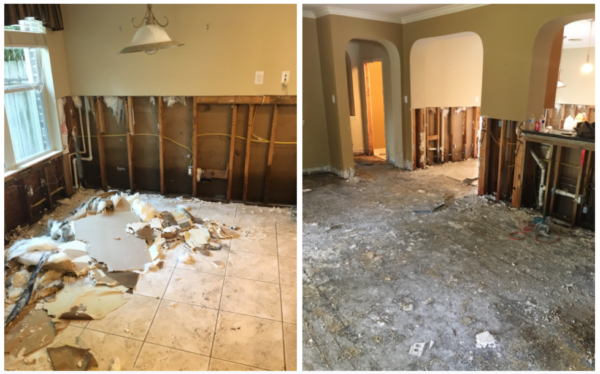How Agents Can Walk First-Time Homebuyers
through Purchasing Flood Insurance
Millions of Americans have moved during the pandemic. Some fled big cities for more space, some sought warmer weather, some downsized, some upsized.
And many of those people are buying a home for the first time, unfamiliar with the ins and outs of insurance. Too often, eager homebuyers come into the insurance office looking to quickly check the mandatory boxes in order to close a mortgage – only to be hit with uninsured flood damage a year later.
Tyler Pearson has over 15 years of experience as an agent with American National Insurance Company in Texas. Below, he shares three tips for educating customers about flood insurance. His overarching advice? “Be your customer’s advocate, not a salesperson.”
1. Listen to Your Customers’ Objections to Flood Insurance
When a customer says they only want the bare minimum insurance package for their new home, don’t just oblige.
Pearson says it’s in both the customer’s and the insurance agent’s best interest to make flood risk part of every conversation with a customer. That’s because many customers, especially first-time homebuyers, aren’t aware of the realities of flood risk and flood insurance.
While homeowners in high-risk FEMA flood zones are required to purchase flood insurance to fulfill the mortgage, homeowners in moderate- to low-risk areas across the country aren’t immune to the threat of financially devastating flooding. Plus, many people mistakenly assume homeowners insurance covers flood damage.
Here are three common objections Pearson has heard repeatedly over the years:
- “It’s not hurricane season, so I don’t need flood insurance.”
- “I’m not legally required to purchase flood insurance, so I don’t need it.”
- “I don’t live by the water, so my property won’t flood.”
These statements aren’t true, but they’d be perfectly reasonable if they were. Always ask your customers why they think they don’t need flood insurance, and take their answer as an opportunity to educate.
Go to our Flood Education page to learn about flood insurance straight from flood experts.
2. Tell Stories to Put Flood Risk in Perspective
Pearson says telling stories is one of the most effective ways to show customers why flood risk needs to be taken seriously.
Just outside of Houston on the Gulf Coast in Friendswood, Texas, where Pearson serves his customers, Hurricane Harvey is still fresh in the collective memory. He often shares his parents’ experience after the storm as a cautionary tale of the severity of flood damage in the region.
Pearson’s parents’ home flooded with 33 inches of water, and he has pictures of the aftermath to show customers how three feet of water can completely gut a property.

Tyler shares these photos of his parents’ home after Hurricane Harvey to show what severe flood damage looks like.
But disastrous hurricane damage isn’t the only flood risk in Pearson’s community. During the February 2021 winter storm in Texas, pipe bursts caused a number of localized flooding events in Houston. Pearson shares one story of how just three inches of water leaked into a customer’s entire house, resulting in a claim of over $50,000.
Both stories underscore how climate change is amplifying flood risks of all kinds. “I tell my customers, when in your lifetime have you seen snow on the ground in Texas? When have you seen us run out of names in the alphabet during a hurricane season? Customers can’t argue with those facts,” says Pearson.
Check out our Regional Toolkits to learn more about flood risks in different parts of the country.
3. Break Down the Numbers to Illustrate the Financial Importance of Flood Insurance
“Do you want to spend $12,000 to protect your home or $260,000 to repair it?”
Take Pearson’s parents again for example: they paid $12,000 cumulatively for flood insurance coverage before Harvey, but they would have had to have paid a whopping $260,000 for the damage if they hadn’t been insured.
Numbers, like stories, are powerful tools of persuasion. Pearson recommends giving customers sample quotes and claims estimates upfront to show how much money they’ll save with flood insurance in the event of a flood.
“We’ve seen just six inches of water do upwards of $50,000 of damage,” says Pearson. If a customer has objections about the necessity of flood insurance outside a high-risk area, these numbers can be especially telling.
Pearson says it’s also helpful to break down the cost of flood insurance in relatable terms. “For a premium of about $500 per year, that’s around $50 per month – the cost of one dinner out,” he says. “You can tell your customers, for the cost of one dinner out per month, you can have financial protection for your home and peace of mind.”
Pearson often shares this video with his customers to put flood damage costs and flood insurance coverage in perspective.
Our Risk Assessment tool can help you get started with pricing flood insurance for your customers.
Be Your Customer’s Advocate, Make More Sales
Educating homeowners about flood risk is a win-win for agents and customers.
If agents try to force more policies on a customer without explaining why, customers might get turned off.
But when agents take the time to educate their customers about the true nature of flood risk and the financial necessity of flood insurance, customers will be a lot more receptive. And new homeowners will be protected from crippling financial losses if a pipe bursts or a hurricane makes landfall.
Head to our Agent Portal for more guidance on how to have the flood insurance conversation with your customers.
Blog Articles
